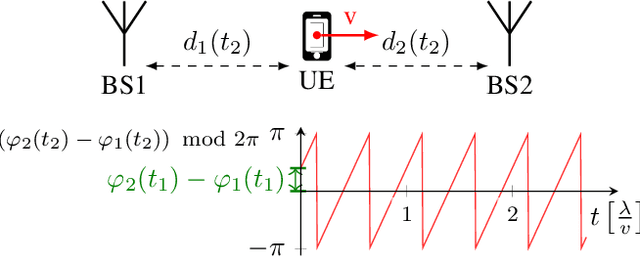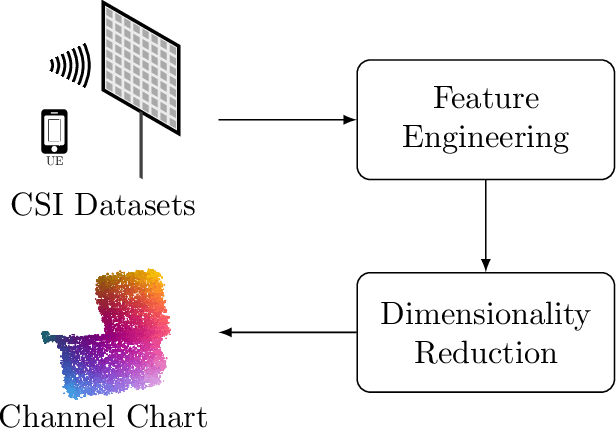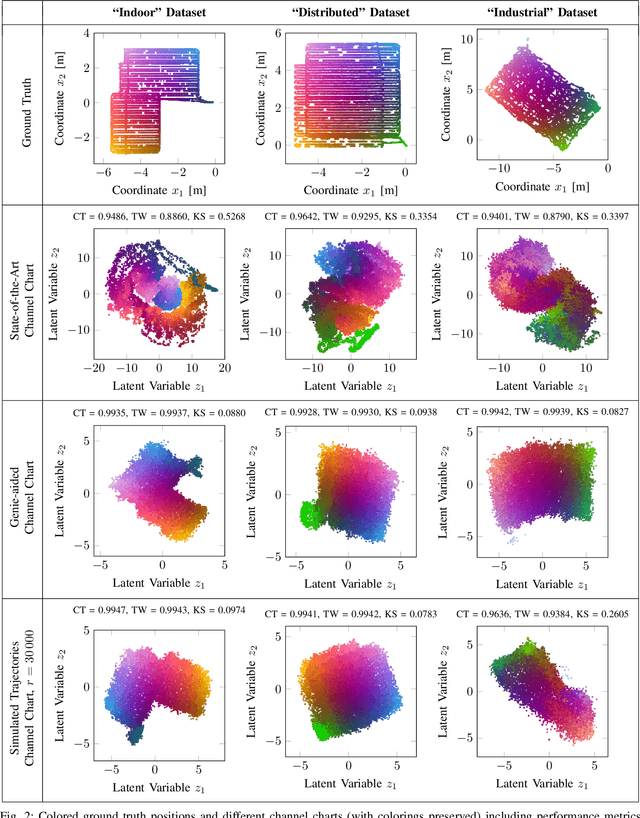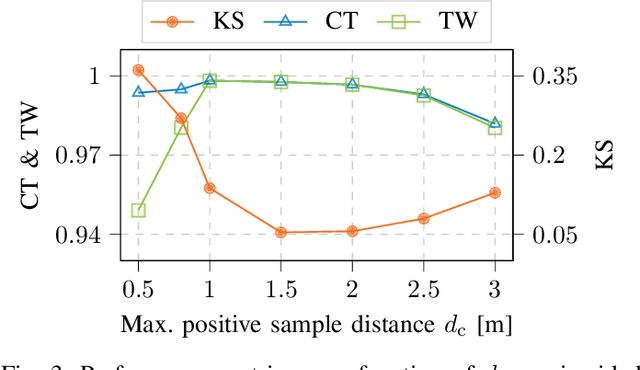Phillip Stephan
Passive Channel Charting: Locating Passive Targets using Wi-Fi Channel State Information
Apr 14, 2025Abstract:We propose passive channel charting, an extension of channel charting to passive target localization. As in conventional channel charting, we follow a dimensionality reduction approach to reconstruct a physically interpretable map of target positions from similarities in high-dimensional channel state information. We show that algorithms and neural network architectures developed in the context of channel charting with active mobile transmitters can be straightforwardly applied to the passive case, where we assume a scenario with static transmitters and receivers and a mobile target. We evaluate our method on a channel state information dataset collected indoors with a distributed setup of ESPARGOS Wi-Fi sensing antenna arrays. This scenario can be interpreted as either a multi-static or passive radar system. We demonstrate that passive channel charting outperforms a baseline based on classical triangulation in terms of localization accuracy. We discuss our results and highlight some unsolved issues related to the proposed concept.
Uncertainty-Aware Dimensionality Reduction for Channel Charting with Geodesic Loss
Dec 02, 2024Abstract:Channel Charting is a dimensionality reduction technique that learns to reconstruct a low-dimensional, physically interpretable map of the radio environment by taking advantage of similarity relationships found in high-dimensional channel state information. One particular family of Channel Charting methods relies on pseudo-distances between measured CSI datapoints, computed using dissimilarity metrics. We suggest several techniques to improve the performance of dissimilarity metric-based Channel Charting. For one, we address an issue related to a discrepancy between Euclidean distances and geodesic distances that occurs when applying dissimilarity metric-based Channel Charting to datasets with nonconvex low-dimensional structure. Furthermore, we incorporate the uncertainty of dissimilarities into the learning process by modeling dissimilarities not as deterministic quantities, but as probability distributions. Our framework facilitates the combination of multiple dissimilarity metrics in a consistent manner. Additionally, latent space dynamics like constrained acceleration due to physical inertia are easily taken into account thanks to changes in the training procedure. We demonstrate the achieved performance improvements for localization applications on a measured channel dataset
Channel Charting-Based Channel Prediction on Real-World Distributed Massive MIMO CSI
Oct 15, 2024Abstract:Distributed massive MIMO is considered a key advancement for improving the performance of next-generation wireless telecommunication systems. However, its efficacy in scenarios involving user mobility is limited due to channel aging. To address this challenge, channel prediction techniques are investigated to forecast future channel state information (CSI) based on previous estimates. We propose a new channel prediction method based on channel charting, a self-supervised learning technique that reconstructs a physically meaningful latent representation of the radio environment using similarity relationships between CSI samples. The concept of inertia within a channel chart allows for predictive radio resource management tasks through the latent space. We demonstrate that channel charting can be used to predict future CSI by exploiting spatial relationships between known estimates that are embedded in the channel chart. Our method is validated on a real-world distributed massive MIMO dataset, and compared to a Wiener predictor and the outdated CSI in terms of achievable sum rate.
Leveraging the Doppler Effect for Channel Charting
Apr 15, 2024



Abstract:Channel Charting is a dimensionality reduction technique that reconstructs a map of the radio environment from similarity relationships found in channel state information. Distances in the channel chart are often computed based on some dissimilarity metric, which can be derived from angular-domain information, channel impulse responses, measured phase differences or simply timestamps. Using such information implicitly makes strong assumptions about the level of phase and time synchronization between base station antennas or assumes approximately constant transmitter velocity. Many practical systems, however, may not provide phase and time synchronization and single-antenna base stations may not even have angular-domain information. We propose a Doppler effect-based loss function for Channel Charting that only requires frequency synchronization between spatially distributed base station antennas, which is a much weaker assumption. We use a dataset measured in an indoor environment to demonstrate that the proposed method is practically feasible with just four base station antennas, that it produces a channel chart that is suitable for localization in the global coordinate frame and that it outperforms other state-of-the-art methods under the given limitations.
Augmenting Channel Charting with Classical Wireless Source Localization Techniques
Dec 04, 2023Abstract:Channel Charting aims to construct a map of the radio environment by leveraging similarity relationships found in high-dimensional channel state information. Although resulting channel charts usually accurately represent local neighborhood relationships, even under conditions with strong multipath propagation, they often fall short in capturing global geometric features. On the other hand, classical model-based localization methods, such as triangulation and multilateration, can easily localize signal sources in the global coordinate frame. However, these methods rely heavily on the assumption of line-of-sight channels and distributed antenna deployments. Based on measured data, we compare classical source localization techniques to channel charts with respect to localization performance. We suggest and evaluate methods to enhance Channel Charting with model-based localization approaches: One approach involves using information derived from classical localization methods to map channel chart locations to physical positions after conventional training of the forward charting function. Foremost, though, we suggest to incorporate information from model-based approaches during the training of the forward charting function in what we call "augmented Channel Charting". We demonstrate that Channel Charting can outperform classical localization methods on the considered dataset.
Angle-Delay Profile-Based and Timestamp-Aided Dissimilarity Metrics for Channel Charting
Sep 07, 2023Abstract:Channel charting is a self-supervised learning technique whose objective is to reconstruct a map of the radio environment, called channel chart, by taking advantage of similarity relationships in high-dimensional channel state information. We provide an overview of processing steps and evaluation methods for channel charting and propose a novel dissimilarity metric that takes into account angular-domain information as well as a novel deep learning-based metric. Furthermore, we suggest a method to fuse dissimilarity metrics such that both the time at which channels were measured as well as similarities in channel state information can be taken into consideration while learning a channel chart. By applying both classical and deep learning-based manifold learning to a dataset containing sub-6GHz distributed massive MIMO channel measurements, we show that our metrics outperform previously proposed dissimilarity measures. The results indicate that the new metrics improve channel charting performance, even under non-line-of-sight conditions.
Improving Triplet-Based Channel Charting on Distributed Massive MIMO Measurements
Jun 20, 2022



Abstract:The objective of channel charting is to learn a virtual map of the radio environment from high-dimensional CSI that is acquired by a multi-antenna wireless system. Since, in static environments, CSI is a function of the transmitter location, a mapping from CSI to channel chart coordinates can be learned in a self-supervised manner using dimensionality reduction techniques. The state-of-the-art triplet-based approach is evaluated on multiple datasets measured by a distributed massive MIMO channel sounder, with both co-located and distributed antenna setups. The importance of suitable triplet selection is investigated by comparing results to channel charts learned from a genie-aided triplet generator and learned from triplets on simulated trajectories through measured data. Finally, the transferability of learned forward charting functions to similar, but different radio environments is explored.
Channel Sounder with Over-the-Air Antenna Synchronization: Absolute Phase and Timing Calibration Using Known Transmitter Locations
Jun 13, 2022



Abstract:Synchronization of transceiver chains is a major challenge in the practical realization of massive MIMO and especially distributed massive MIMO. While frequency synchronization is comparatively easy to achieve, estimating the carrier phase and sampling time offsets of individual transceivers is challenging. However, under the assumption of phase and time offsets that are constant over some duration and knowing the positions of several transmit and receive antennas, it is possible to estimate and compensate for these offsets even in scattering environments with multipath propagation components. The resulting phase and time calibration is a prerequisite for applying classical antenna array processing methods to massive MIMO arrays and for transferring machine learning models either between simulation and deployment or from one radio environment to another. Algorithms for phase and time offset estimation are presented and several investigations on large datasets generated by an over-the-air-synchronized channel sounder are carried out.
 Add to Chrome
Add to Chrome Add to Firefox
Add to Firefox Add to Edge
Add to Edge